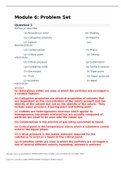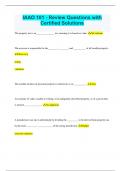Atomic
Structure
Chemistry AS1
Year 13
, Atomic Structure - Background Knowledge
John Dalton Theory,1804 – Now Incorrect
Element is composed of atoms of identical size and mass
(isotopes prove wrong)
Atoms are invisible and remain unchanged during chemical
reactions (the transfer of electrons proves this wrong)
Bohr-Rutherford Model, 1912 – Most modern
Central positively-charged nucleus of very high density
Surrounded by much larger-sized volumes in which electrons
move
Mass Charge Location
Proton 1 +1 Nucleus
Neutron 1 0 Nucleus
Electron 1 -1 Orbital Shells /
1840 Energy Levels
No. of Protons =
Atomic Number
Element
No. of Electrons =
Atomic Number Relative
Atomic Mass
No. of Neutrons = Atomic
RAM – Atomic number Number
No of shells = period number
No of electrons in outer shell = group number
1
, Mass Spectronomy
Determines the mass of atoms and molecules
A MASS SPECTRONOMER atomises and ionises a sample, producing
ions with a single positive charge – ALL ions in a mass spectrum have a
single positive charge
Accelerated by electric field
Magnetic field deflects positive ions
Extent of deflection depends on mass and charge of ion
Altering magnetic field strength brings ions to focus on detector
To work out RAM:
1. Add all the products of the RIM multiplied by its relative abundance
2. Divide by 100
Data obtained can be from:
An Element Spectrum will show masses and relative abundance
for all istopes of element
Data supplied in table or a mass spectrum
Relative Isotopic Mass Relative Abdunance
50 7
52 74
53 15
54 4
2
Structure
Chemistry AS1
Year 13
, Atomic Structure - Background Knowledge
John Dalton Theory,1804 – Now Incorrect
Element is composed of atoms of identical size and mass
(isotopes prove wrong)
Atoms are invisible and remain unchanged during chemical
reactions (the transfer of electrons proves this wrong)
Bohr-Rutherford Model, 1912 – Most modern
Central positively-charged nucleus of very high density
Surrounded by much larger-sized volumes in which electrons
move
Mass Charge Location
Proton 1 +1 Nucleus
Neutron 1 0 Nucleus
Electron 1 -1 Orbital Shells /
1840 Energy Levels
No. of Protons =
Atomic Number
Element
No. of Electrons =
Atomic Number Relative
Atomic Mass
No. of Neutrons = Atomic
RAM – Atomic number Number
No of shells = period number
No of electrons in outer shell = group number
1
, Mass Spectronomy
Determines the mass of atoms and molecules
A MASS SPECTRONOMER atomises and ionises a sample, producing
ions with a single positive charge – ALL ions in a mass spectrum have a
single positive charge
Accelerated by electric field
Magnetic field deflects positive ions
Extent of deflection depends on mass and charge of ion
Altering magnetic field strength brings ions to focus on detector
To work out RAM:
1. Add all the products of the RIM multiplied by its relative abundance
2. Divide by 100
Data obtained can be from:
An Element Spectrum will show masses and relative abundance
for all istopes of element
Data supplied in table or a mass spectrum
Relative Isotopic Mass Relative Abdunance
50 7
52 74
53 15
54 4
2











